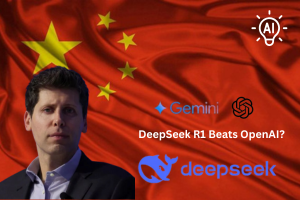Open AI CEO Sam Altman on the Impressive DeepSeek R1 Model
DeepSeek's R1 model has made a significant impact on the AI landscape, demonstrating impressive capabilities that have challenged established players like ChatGPT and Gemini. The emergence of DeepSeek, despite the challenges posed by AI chip restrictions, highlights the growing influence of China in the AI domain. OpenAI CEO Sam Altman's acknowledgment of R1's "impressive" capabilities underscores the competitive nature of the AI race and the need for continuous innovation. The future of AI promises to be an exciting and dynamic era, with ongoing competition driving advancements in this transformative field. However, the recent market turmoil, particularly the steep decline in Nvidia's stock price, indicates that the impact of DeepSeek R1 is far-reaching and has the potential to significantly reshape the AI landscape in the coming years.
ARTIFICIAL INTELLIGENCEUSASCIENCE & TECHNOLOGYCHINA


OpenAI CEO Acknowledges DeepSeek R1, But Market Reeling from Impact
The AI world has been buzzing since the emergence of DeepSeek, a Chinese AI startup that has shaken the foundations of the industry. Their latest model, R1, has not only garnered significant attention but has also drawn praise from unexpected quarters – OpenAI CEO, Sam Altman.
The Rise of DeepSeek and the R1 Model
DeepSeek, a relatively young player in the AI arena, has rapidly gained traction with its innovative approach. The company, based in Hangzhou, China, has been making waves with its AI models, particularly the recently released R1.
What is DeepSeek R1?
R1 is a general-purpose AI system developed by DeepSeek.
It's known for its remarkable performance across various tasks, often matching or even surpassing the capabilities of established models like ChatGPT and Gemini from Google.
A key feature is its cost-effectiveness. DeepSeek claims R1 can perform tasks at a fraction of the cost compared to models like OpenAI's o1, potentially as low as $0.55 per million input tokens compared to $15.
R1 is also free to use, making it highly accessible to the public. This contrasts sharply with subscription-based models like OpenAI's o1 and Claude, which often have usage limits.
DeepSeek R1 is open-source, meaning the underlying code is publicly available. This has significant implications, as it democratizes access to advanced AI technology and challenges the dominance of closed-source models.
Why is R1 so Cheap?
DeepSeek's ability to achieve such low costs is attributed to significant technological breakthroughs. Notably, DeepSeek previously demonstrated remarkable cost-efficiency in training its DeepSeek-V3 model, achieving high performance with a budget of less than $6 million using lower-capability Nvidia H800 chips. This highlights the company's focus on optimizing model training and minimizing reliance on the most expensive hardware.
The Impact of AI Chip Restrictions on China
The rise of DeepSeek amidst a backdrop of increasing restrictions on the export of advanced AI chips to China adds another layer of intrigue to this story. These restrictions, aimed at hindering China's progress in AI development, have spurred Chinese companies to find innovative ways to overcome these limitations. DeepSeek's success in developing a competitive AI model despite these challenges serves as a testament to the ingenuity and resilience of Chinese AI researchers.
The Effect on American AI Companies
The emergence of DeepSeek has sent shockwaves through the American tech landscape. The sudden rise of a formidable competitor from China has rattled investors, leading to significant market fluctuations. Companies like Nvidia, whose powerful AI chips are crucial for training advanced AI models, experienced a sharp decline in their stock prices, reflecting the growing anxiety within the industry. Nvidia, a key player in the AI chip market, suffered a record one-day loss of $593 billion in market value, marking the largest single-day loss for any company on Wall Street. This dramatic fall underscores the deep concern amongst investors about the potential impact of DeepSeek's R1 on Nvidia's dominance in the AI chip market.
Sam Altman's Acknowledgement
In a surprising turn of events, OpenAI CEO Sam Altman recently acknowledged the impressive capabilities of DeepSeek's R1 model. While acknowledging the competitive landscape, Altman emphasized the importance of continued innovation and the need for the AI community to push the boundaries of what's possible. Altman's statement is significant for several reasons. Firstly, it serves as an acknowledgment of DeepSeek's achievements from a key figure in the AI industry. Secondly, it highlights the growing recognition of China's growing influence in the AI domain. Finally, it underscores the competitive nature of the AI race and the need for continuous innovation and adaptation.
The Future of AI
The AI landscape is evolving rapidly, with new players and technologies emerging constantly. The rise of DeepSeek and its R1 model serves as a stark reminder that the competition in AI is fierce and the playing field is constantly shifting.
The future of AI will likely be characterized by continued innovation, intense competition, and a dynamic interplay between different players and technologies. It remains to be seen how the AI landscape will evolve in the coming years, but one thing is certain – the race for AI supremacy is far from over.
